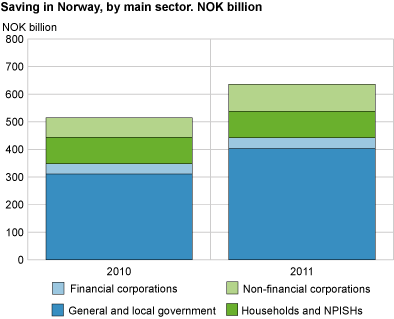Content
Published:
This is an archived release.
Increased savings in Norway in 2011
Preliminary figures show that savings in Norway were NOK 636 billion, which is almost NOK 121 billion higher than the previous year. The central government’s income from petroleum activities contributed most to this increase.
National income for Norway in 2011 was NOK 2 376 billion. This is 8.6 per cent higher than in 2010.
Gross domestic product (GDP) increased by NOK 187 billion in 2011, and this explains much of the rise in national income. For further details of GDP, see the link to Quarterly National Accounts . Primary income from abroad also helped to pull up the national income. When including net transfers and benefits from abroad, disposable income totalled NOK 2 347 billion in 2011.
Savings in Norway are estimated at NOK 636 billion, which is an increase of NOK 121 billion. The savings rate; savings as a share of disposable income, was 27 per cent. This is three percentage points higher than in 2010.
Continued increase in disposable real income for Norway
After a sharp decline in 2009, there has been growth in disposable real income for Norway in the last two years. Preliminary figures for 2011 show that disposable real income grew by 6.3 per cent in 2011, after rising by 5.3 per cent the year before. The main factor behind the increase from 2010 to 2011 was the improvement in the terms of trade. Price trends of oil and gas are important for the development of terms of trade and contributed by 4.3 percentage points to growth in disposable real income. Overall, the terms of trade contributed by 4 percentage points to growth.
| 2008 | 2009 | 2010 | 2011 | ||||||||||||||||||||||||||||||||||||||||||||||||||||||||||||||||||||||||||||
|---|---|---|---|---|---|---|---|---|---|---|---|---|---|---|---|---|---|---|---|---|---|---|---|---|---|---|---|---|---|---|---|---|---|---|---|---|---|---|---|---|---|---|---|---|---|---|---|---|---|---|---|---|---|---|---|---|---|---|---|---|---|---|---|---|---|---|---|---|---|---|---|---|---|---|---|---|---|---|---|
| Real disposable income for Norway | 5.8 | -12.0 | 5.3 | 6.3 | |||||||||||||||||||||||||||||||||||||||||||||||||||||||||||||||||||||||||||
| Contribution to growth from | |||||||||||||||||||||||||||||||||||||||||||||||||||||||||||||||||||||||||||||||
| Production growth in the oil business | -0.8 | -0.7 | -1.3 | -0.8 | |||||||||||||||||||||||||||||||||||||||||||||||||||||||||||||||||||||||||||
| Production growth other | 0.2 | -2.0 | 1.6 | 2.3 | |||||||||||||||||||||||||||||||||||||||||||||||||||||||||||||||||||||||||||
| Change in terms of trade | 6.6 | -10.2 | 4.2 | 4.0 | |||||||||||||||||||||||||||||||||||||||||||||||||||||||||||||||||||||||||||
| Of which, prices for crude oil and gas | 5.9 | -9.2 | 3.0 | 4.3 | |||||||||||||||||||||||||||||||||||||||||||||||||||||||||||||||||||||||||||
| Change in Balance of income and current transfers | -0.2 | 0.9 | 0.8 | 0.8 | |||||||||||||||||||||||||||||||||||||||||||||||||||||||||||||||||||||||||||
Increased savings in general government
Savings in Norway are mainly through central government. The central government's share of total savings amounted to 64 per cent in 2011; an increase of 3 percentage points compared to the year before. Savings in central government increased by almost NOK 89 billion from 2010 to 2011, and ended at NOK 409 billion. The increase is mainly explained by increased revenues from petroleum taxes and dividends. In contrast to the central government, the local government sector continues to have negative savings, with total savings in public administration of about NOK 403 billion in 2011. The saving rate in the public sector was 41 per cent in 2011, up 5 percentage points from the year before.
Continued increase in disposable real income for households
Disposable income for households and non-profit institutions serving households was NOK 1 188 billion in 2011, which is an increase of 5.4 per cent compared with the previous year. Compensation of employees, which is the most important source of income in the household sector, went up approximately 6 per cent in 2011.
Disposable real income increased by 4 per cent. Increases in compensation of employees, payments and benefits from general government and net property income contributed to the growth in real disposable income.
The growth in households’ disposable income exceeded the growth in final consumption expenditures in 2011, which resulted in higher savings. Households’ savings amounted to approximately NOK 98 billion, which is NOK 27 billion more than in 2010. Savings’ share of disposable income; the saving rate, is measured to be 8.2 per cent in 2011, compared to 6.3 per cent in 2010.
For more information about the household sector, go to National accounts, quarterly sector accounts.
Decreased net lending for corporations
Preliminary figures for 2011 show that savings in the corporate sector were NOK 135 billion, almost unchanged from the previous year. Gross investment less depreciation was higher than savings, and this meant that companies had negative net lending or net borrowing of NOK 2.5 billion.
RevisionsNet property income from abroad has been revised for 2010 as a result of new information. |
Tables
The statistics is now published as National accounts, non-financial sector accounts.
Additional information
Contact
-
Statistics Norway's Information Centre
E-mail: informasjon@ssb.no
tel.: (+47) 21 09 46 42

